Table of Contents[Hide][Show]
Looking for foods that are good for your skin? We’d like to suggest one that you may not have thought of…
While kale has had its well-deserved time in the spotlight, and coconut water continues to reign supreme, both of them need to make room for the skin-beautifying ingredient many of us have been ignoring — radishes.
If you’re not already incorporating this food into your diet, it’s time to start.
Here’s why radishes need to be on your plate at your next meal, or even in your next homemade skin mask.
What is a Radish?
The radish (Raphanus sativus) is an edible root vegetable that comes from a plant that’s part of the cabbage family. It’s been around for a long time, though scientists aren’t really sure from where it originated. Wild forms of the plant have been found in Southeast Asia, which may be a sign that they first grew there, but the Greeks and Romans were using them by the third century B.C. It’s believed radishes were brought to America in the 1600s.
There are a number of different varieties of the plant, but it’s the spicy ones that we’re most familiar with. Hardy and pest resistant, they include a number of chemical compounds that give them their unique sharp flavor. It’s these chemicals, along with a number of vitamins and minerals, that seem to be responsible for the radish’s many health benefits.
Radishes make a great garnish for salads and other vegetable dishes because of their distinct flavor and nutritional content. A full cup of radishes contains only about 19 calories, along with a high water content that helps keep you hydrated and satisfied. (Though realistically, you don’t want to eat a full cup of radish slices. Below we have some other ideas for how to enjoy them.)
Before we go into how radishes specifically beautify your skin, we want to talk about some of their most potent health benefits. And in the end, what’s good for your health is good for your complexion.
The Amazing Health Benefits of Radishes
Radishes have a lot to brag about…
Detoxifying
Dieticians know that radishes are good for the liver, and that they can help flush impurities out of the body. A 1988 book entitled The Treatment of Jaundice included a chapter on clearing a blocked liver with wild celery, caper, and radish. A more recent 2014 study also found that Spanish black radishes had a marked effect on liver function. The researchers wrote: “This study demonstrated that the supplement containing Spanish black radish positively altered the metabolism of acetaminophen, suggesting an effective increase in liver detoxification capacity in humans.”
Ease Digestion
A 2008 study reported that radish juice helped inhibit the formation of gastric ulcers, with researchers concluding that it had “gastroprotective” potential—meaning it helped protect the digestive system. Eating radishes before a meal is said to increase digestive power.
Beyond that, radishes contain indigestible carbs and are high in fiber, making them a great food to ease digestion, reduce the symptoms of constipation, and limit water retention.
Soothe Urinary Problems
Radishes are considered a diuretic vegetable, meaning they promote urination. They also have anti-inflammatory and antibacterial properties, which can help protect against urinary tract infections and potentially encourage healing. There is some evidence that radishes, because of these properties, can also help improve and protect kidney health, and potentially reduce the risk of kidney stones.
May Protect Against Cancer
A number of studies have suggested that radishes may help to protect us against cancer. In 2002, for instance, researchers found that those who consumed more radishes in their diet were at a reduced risk for gallbladder cancer. A 2009 study also noted that radishes contain “isothiocyanates,” naturally occurring small molecules that have the capacity to reduce the activation of carcinogens. Though we know that a diet rich in veggies is protective against cancer in general, the radish has certain antioxidants that may be particularly helpful.
May Help With Blood Sugar
The powerful antioxidants in radishes may help protect against high blood pressure. A 2012 animal study found that a radish leaf extract treatment that lasted for five weeks significantly reduced systolic blood pressure. Radishes are a good source of nitrates, which is converted to nitric oxide in the blood—and nitric oxide helps relax the smooth muscle walls of blood vessels so they dilate more freely. Nitric oxide also helps reduce the risk of blood clots.
5 Ways Radishes Benefit Skin
The raw radish is a powerhouse of vitamins, minerals, and phytonutrients that help nourish, hydrate, and protect the skin from the environment. Some of the benefits for the skin when you eating it regularly may include:
Better Hydrated Skin
The high water content in radishes is good for your skin as well as other body organs, helping to maintain moisture levels. Radishes also contain both omega-3 and omega-6 fatty acids, which are critical for plumping moisture down in the deeper levels of skin.
Younger-looking Skin
A cup of radishes will supply you with about 30 percent of your daily recommended amount of vitamin C. As you may know, vitamin C is critical for firming and tightening and protects from environmental stressors. The root also contains vitamin A.
Fewer Clogged Pores
If you’re suffering from clogged pores and haven’t found a solution, you may want to try black radish juice or pulp in a homemade mask. Mashed white radishes may also do the trick. The key here is the cleansing property, which can help reduce the appearance of pores. The high water content prevents over-drying. Mix radish juice with a few drops of citrus juice to cleanse skin and clogged pores.
Lighten the look of your skin: The vitamin C and A content in radishes, as well as some of its other components, are said to help lighten and brighten the appearance of skin. Mix with yogurt and honey to create a gentle, moisturizing, lightening mask.
Looking for more ways to get radishes into your daily diet? Try these tips:
- Add them to salads (of course!)
- Julienne them and add to risotto
- Roast them
- Add them to your tacos
- Put them in your coleslaw
- Pickle them
- Add them to your tuna salad
- Snack on them with cream cheese and chives
Did you know radishes were good for skin? Please share any recipes you may have.
Sources:
François Du Port – Treatment of Jaundice
Nutra – Spanish Black Radish Shows Detox Benefits, Support Liver Health: Human Data
Department of Pharmacognosy and Medicinal, Aromatic & Poisonous Plants Research Center – Gastroprotective Effect of Radish “Raphanus Sativus” on Experimental Gastric Ulcer Models in Rats
Pakistan Journal of Pharmacology – Physics-Chemical Studies of Indige
European Journal of Cancer Prevention – Diet and Gallbladder Cancer: A Case-Control Study
Acta Pharmacologie Sinica – Are Isothiocyanates Potential Anti-Cander Drugs
SF Gate – What Are the Benefits of Eating Radishes








Wow, thanks for the reminder about radishes. They’re one of those veggies I don’t think of all the time. When I have access to really fresh ones, I love to use the greens in my green drinks. They definitely have a spicy kick! At times I have grown my own radishes. Picking and eating them when they are pretty young means they are a little less spicy. I’m definitely picking some up this week!